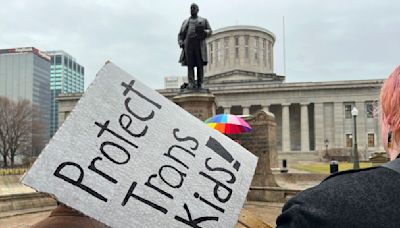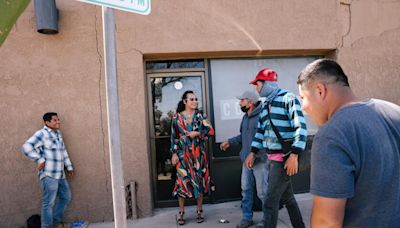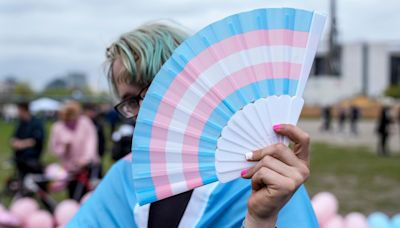Search Results
LGBTQIA+ Stories from Yahoo
- DictionaryTrans·gen·der/ˌtranzˈjendər/
adjective
- 1. denoting or relating to a person whose sense of personal identity and gender does not correspond with their birth sex. "a transgender activist and author"
A transgender person (often shortened to trans person) is someone whose gender identity differs from that typically associated with the sex they were assigned at birth. [1] Some transgender people who desire medical assistance to transition from one sex to another identify as transsexual.
Jun 6, 2023 · Transgender is an umbrella term used to describe people whose gender identity (sense of themselves as male or female) or gender expression differs from socially constructed norms associated with their birth sex. This includes androgynous, bigendered and gender queer people, who tend to see traditional concepts of gender as restrictive.
Jan 27, 2023 · Transgender is a broad term that can be used to describe people whose gender identity is different from the gender they were thought to be when they were born. “Trans” is often used as shorthand for transgender. To treat a transgender person with respect, you treat them according to their gender identity, not their sex at birth.
May 16, 2023 · Transgender is a general term that describes people whose gender identity, or their internal sense of being male, female, or something else, does not match the sex they were assigned at birth. By ...
- Overview
- What does it mean?
- How would a person know if they are transgender?
- Transgender and gender dysphoria
- What to know about transitioning
- Accessing healthcare as a transgender individual
- What is the difference between sexual orientation and gender identity?
- What is the difference between transgender and intersex?
- What is the difference between transgender and gender nonconforming?
- Transgender and nonbinary
A transgender means a person has a different gender identity than their assigned gender at birth.
This article discusses the definition of transgender.
It also looks at other definitions of different gender identities and commonly used terminology, as well as access to healthcare and allyship relating to transgender issues.
LGBTQIA+ resources
To discover more evidence-based health information and resources for LGBTQIA+ individuals, visit our dedicated hub.
Was this helpful?
The National Center for Transgender Equality defines transgender people as those who have a different gender identity to their assigned gender at birth. Some people may also use “trans” as a shortened version for transgender.
Gender identity is the innate knowledge of who a person is. Every person has a gender identity, which may match their assigned sex at birth, or it may be different.
A healthcare professional usually assigns newborns either a male or female sex at birth. If people identify with a different gender to the one they were assigned, they may describe themselves as transgender.
A transgender woman is someone who is currently living as a woman but was assigned a male sex at birth. A transgender man is someone who is currently living as a man but was assigned a female sex at birth.
People may realize they are transgender at any age. Planned Parenthood notes that many people know they are transgender from a young age, and others may not realize until later in life.
People may have a feeling of not fitting in, or may feel uncomfortable emotions when talking about their gender or being seen by others as a gender they do not identify with.
A person can try the following to help them understand their gender identity:
•Write about how they feel in a journal on a regular basis.
•Talk about their feelings with people they trust.
•Talk about their feelings with a therapist or counselor.
Some transgender people may experience severe emotional distress if there is a difference between their gender identity and assigned sex at birth. The medical term for this is gender dysphoria.
Gender dysphoria can affect a person’s health, well-being, and everyday life. By aligning with and expressing their gender identity, people may be able to resolve gender dysphoria.
Transitioning is the term people use for the period of time when they align themselves and their life with their true gender identity, rather than their assigned sex at birth.
Transitioning is not necessary to be transgender, although many transgender people choose to transition at some point.
There are no set steps or criteria for transitioning, and it is individual for each person.
Steps some people may or may not take to transition can include:
•changing their appearance, such as clothing and hairstyle
•changing their name
People may want to search for healthcare professionals and clinics where staff are trans-friendly and have appropriate training and knowledge in transgender issues.
People can find local providers in their state or city through the Centers for Control and Disease Prevention (CDC) list of resources.
The following organizations also provide helpful information and resources:
•World Professional Association for Transgender Health
•Fenway Health
•Whitman-Walker Health
Sexual orientation differs from gender identity. Sexual orientation focuses on who people are attracted to. People of any gender identity can have any sexual orientation.
Learn more about different types of sexual orientations here.
Gender identity is a person’s innate knowledge of their gender. People may identify as a man, woman, nonbinary person, or another gender identity.
Learn more about different types of gender identities here.
The Intersex Society of North America defines intersex as “a general term used for a variety of conditions in which a person is born with a reproductive or sexual anatomy that doesn’t seem to fit the typical definitions of female or male.”
Sex chromosomes determine the biological sex of a baby. Intersex people may have chromosomes typical to a male or female but have no internal or external anatomy that corresponds to biological male or female anatomy.
Transgender people are usually born with genetics and anatomy that match a biological definition of male or female. Transgender people may feel they have a different gender identity to their assigned sex at birth.
Learn more about what it means to be intersex here.
A person who is gender nonconforming does not conform to the stereotypical ideas of gender.
The LGBTQIA Resource Center notes that people more commonly use the term to refer to gender expression instead of gender identity.
People may choose to appear and behave in ways that are more “masculine” or “feminine” than society may stereotypically associate with their gender.
Someone who is gender nonconforming may or may not be transgender. Transgender people may be gender nonconforming or they may conform to the gender stereotypes of the gender they identify with.
People may describe themselves as nonbinary if they do not identify with either a male or female gender. Nonbinary people may not feel they fit into the gender binary of being a man or a woman. People may also use the term genderqueer to describe their gender identity.
Nonbinary people may identify with elements of being both male and female, a different gender, or no gender. Some people may have a fluid gender that changes over time.
Transgender people may be nonbinary, but many transgender people identify as either a man or a woman.
Learn more about being nonbinary here.
- Beth Sissons
2 days ago · transgender, term self-applied by persons whose gender identity varies from that traditionally associated with their apparent biological sex at birth. In its original and narrower sense, transgender referred to males and females who respectively gender-identify as females and males. In a later and broader sense, it has come to designate persons ...
Jul 9, 2016 · Transgender people come from every region of the United States and around the world, from every racial and ethnic background, and from every faith community. Transgender people are your classmates, your coworkers, your neighbors, and your friends. With approximately 1.4 million transgender adults in the United States—and millions more around the world—chances are that you've met a ...
A transgender person (often shortened to trans person) is someone whose gender identity differs from that typically associated with the sex they were assigned at birth. Some transgender people who desire medical assistance to transition from one sex to another identify as transsexual. Wikipedia
Trending Now









